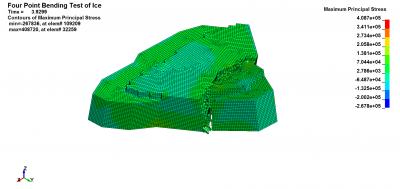Ice island deterioration model
Significant research has been carried out in the past to identify the physical processes or mechanisms involved in iceberg deterioration. Most deterioration models consider surface melting, wave erosion and localized calving loss at the waterline notch. These are the processes responsible for most of the deterioration that icebergs undergo. However, for extensive, flat ice islands, it is recognized that large-scale fracture or calving due to the formation of an underwater ram plays a very important role in their deterioration rate. To date, there are only a few models that attempt to capture this large-scale fracture process.

Simulated calving event observed in an aerial video captured near St. Lewis, Labrador This is a snapshot of the model predicting a calving event that was observed in an aerial video captured near St. Lewis, Labrador.
Postdoctoral Fellow Dr. Mahmud Sazidy is developing an ice island deterioration model using Finite Element Analysis (FEA) software to investigate the role of large-scale fracture in ice island deterioration due to the shape of the sidewall of their keels (the underwater portion of an ice island). The model utilizes a simple strength-based failure mechanism avoiding the traditional approach of damage mechanics and fracture mechanics, which results a computationally efficient and user-friendly fracture assessment tool. So far, the model has been successfully tested and validated against an iceberg calving event observed in an aerial video captured near St. Lewis (“Iceberg Alley”), Labrador. Further tests are underway to examine the model against Petermann Ice Island (PII-B), Berghaus and other ice island profiles. Work is also ongoing to collect more ice island profiles from the field to study the influence of sail and keel geometries on the large scale fracture of ice islands.
The video shows a simulation of the calving observed by an unihabited aerial vehicle (UAV) near St. Lewis, Labrador.
This research is funded by the Ontario Ministry of Research and Innovation and Polar Knowledge Canada, and is supervised by Greg Crocker, Derek Mueller and Shawn Kenny. Anna Crawford has helped to process ice island profile data.
